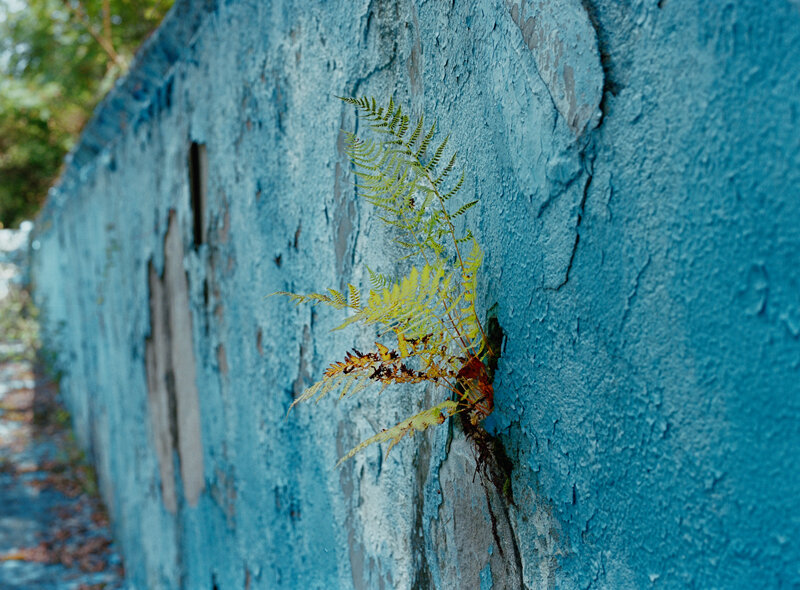Q+A / Marisa Scheinfeld
THE CATSKILLS VIRTUAL BOOK TOUR CELEBRATES CONTEMPORARY CATSKILLS WRITING THROUGH EXCLUSIVE AUTHOR INTERVIEWS AND ENCOURAGES PEOPLE TO SUPPORT LOCAL WRITERS AND INDEPENDENT BOOKSELLERS.
GET READY TO FIND YOUR NEXT GREAT CATSKILLS READ.
I was initially drawn to The Borscht Belt: Revisiting the Remains of America's Jewish Vacationland because of its striking cover image. I suspect this is the case for many other readers.
Marisa Scheinfeld’s photograph, showing a lounge chair atop a carpet of ferns at the remains of Grossinger's Catskill Resort and Hotel, is a perfect encapsulation of the book’s exploration of the line between past and present, life and decay. I think it is easy to rubberneck when it comes to ruins, but Marisa’s book and photographs transcend that impulse. The book situates these images within their cultural significance and history, a history that is deeply personal to Marisa and her family. The Borscht Belt is a book that lingers with you and I recommend it to anyone looking to connect with an important time and place in local history.
Marisa GRACIOUSLY ANSWERED OUR QUESTIONS ABOUT THE BOOK AND HER connection to the Catskills. IF YOU WANT TO READ THE BOOK, WE ENCOURAGE YOU TO ORDER IT FROM A CATSKILLS BOOKSTORE (MOST ARE DOING ONLINE/PHONE ORDERS, SHIPPING, AND CURBSIDE PICKUP!).
How would you describe your book to readers?
THE BORSCHT BELT is a photography and text-based book that presents a contemporary view of the abandoned hotels and bungalow colonies of the former Borscht Belt, an area located in Sullivan and Ulster Counties in the southernmost part of the Catskills. In its heyday during the 1950s the Borscht Belt provided leisure, entertainment and a sense of community for Jewish-Americans. Comprised of color photographs, the photographs in the book depict the now-defunct physical spaces of Borscht Belt architecture such as lobbies, pools, dining rooms, guest rooms, showrooms and stages. The book is rooted in history and touches upon the era’s former glory —but is truly a raw, present-day view of the remains of the Borscht Belt. It is my hope the book brings up thoughts about memory, loss, and the intense, surreal, sad and beautiful process of time and of change. I often refer to the book as an elegy to the Borscht Belt, but in the same breath, it’s also a celebration.
Guest Room, Tamarack Lodge, Greenfield Park, NY. Photograph by Marisa Scheinfeld.
What is your personal connection to the Catskills? How did those ties influence the book?
I grew up in the heart of the Borscht Belt in Kiamesha Lake just outside of Monticello, however today my parents live in Rock Hill. As a former local, I am indelibly connected to the project. As a child I frequented some Borscht Belt’s hotels with my grandparents. My Grandpa Jack was a card shark who loved to play in the cardrooms at Kutsher’s and the Concord. He and my grandmother Ruth owned a townhouse in Hidden Ridge, a condo community adjacent to Kutshers. During my teenage years, I was a lifeguard at the Concord until it closed in the fall of 1996. As an adult, I went back – and that is what this book is -- the product of a five-year study of the remaining hotels and bungalows from the era, in whatever form I found them. From large expansive compounds with multiple structures to singular pools cast off in the woods that have become ponds, the book is a documentation of the remains of a glorious and cherished era. Since its release in October 2016 by Cornell University Press, about half of the locations in the book have disappeared, some having collapsed on themselves while others entirely demolished with new structures and uses happening on the land.
Basketball Courts, Kutsher's, Monticello, NY. Photograph by Marisa Scheinfeld
There is something deeply sad about the photographs you captured, but still beautiful and respectful of the history. How did you find that balance, particularly with subject matter that is so nostalgic for so many people?
Thank you for saying that. I went into the Borscht Belt’s former spaces with a lot of knowledge, having conducted much research beforehand. This early investigation of writing and visuals (old photographs, postcards, etc.) allowed me to piece together a timeline and understand the past. It was also necessary to learn about the current state of each hotel or bungalow – largely left to ruin – for safety reasons and for access.
For me, the process of photography involves thought and contemplation. While walking through the indoor pool at Grossingers, a masterpiece in its own right, I am without a doubt looking for scenes that catch my eye -such as narratives, colors, textures and light. In addition, there’s the sentiment; the feelings and emotions I experience while making the photograph. Encountering a plant in early spring, growing through the floor, through layers of earth and concrete, inside of an architectural gem gone south, is a sublime thing. I remember becoming so enamored with that little plant and amazed at how delicate but also how strong it was. In the book there is a photograph of the pool table my grandpa Jack and I would play pool on. I cried all the way home after making that photograph. These places are imbued with history and memory, and so many stories, and there’s a lot of possible feelings and commentary in that. I feel a definite sense of gladness knowing the images pulls on the heartstrings of others, too.
Indoor Pool #3, Grossinger's Catskill Resort and Hotel, Liberty, NY. Photograph by Marisa Scheinfeld
What book do you like to recommend to people, Catskills-themed or not?
I enjoy anything by Joan Didion. I am also a fan of Rebecca Solnit’s A Field Guide to Getting Lost and A History of Walking. On my bookshelf sits a copy of Kate Palmer Alber’s Uncertain Histories. I am using it for research and ideas towards my second book, which is a slow burn as I am a fairly new mother to a 10-month-old named Jack, who my husband and I named in honor of my card-shark of a grandfather. As far as Catskills themed books I am a huge fan of Ross Padluck’s book Catskill Resorts: Lost Architecture of Paradise. In it he pieces together heyday photographs, postcards, brochures, and architectural drawings of many hotels. It’s the opposite of my book – very clean. Sullivan County Historian John Conway also has written many gems about the region.
Ice Skating Rink, Nevele Grande Hotel, Ellenville, NY. Photograph by Marisa Scheinfeld.
Where can readers go to learn more about The Borscht Belt: Revisiting the Remains of America's Jewish Vacationland?
The book has an official website, www.borschtbeltbook.com. You can also visit, and purchase a copy at Cornell Press: https://www.cornellpress.cornell.edu/book/9781501700590/the-borscht-belt/#bookTabs=1, your local independent bookstore. Also, Amazon. https://www.cornellpress.cornell.edu/book/9781501700590/the-borscht-belt/#bookTabs=1
When things get back to a more normal way of life, the traveling exhibition (http://www.borschtbeltrevisited.com/traveling-exhibition) that accompanies the book will be opening at the New York State Museum. It was supposed to open in June but due to the current pandemic, we are going with the expression “coming in 2020.” If anyone is interested, sign up for my very sporadic mailing list on the book’s website and I will send out an email about the opening, reception and book talks, hopefully taking place in the fall.
Interview by Kelli Huggins, Visitor Experience Coordinator
Outdoor Pool, Rosemond Hotel, Woodbourne, NY. Photograph by Marisa Scheinfeld.
When ordering books, we encourage you to support our Catskills independent booksellers, like those listed below (if we forgot to tag a store, let us know and we'll add it to the list). Most are currently doing remote orders, shipping, and curbside pickup:
Briars and Brambles Books
The Golden Notebook Bookstore
Hobart Book Village
Inquiring Minds Coffee House and Bookstore
Magpie Bookshop
Mirabai Books - Woodstock, NY
MONIQUE'S BOOKS BOUTIQUE
Rough Draft Bar & Books






